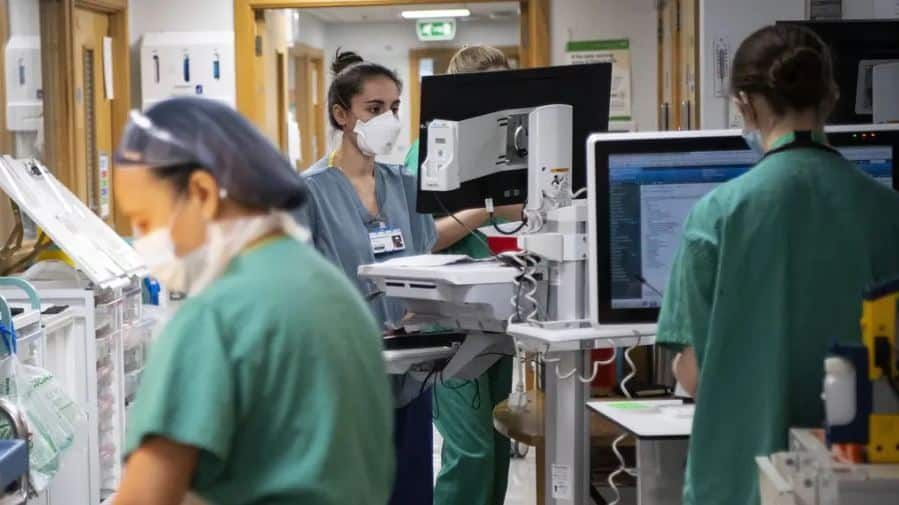
NHS waiting lists in England have climbed to a new record high of 7.6 million.
Data published by NHS England on Thursday revealed 7.6 million people were waiting to start treatment at the end of June, up from 7.5 million in May.
The figure is the highest since records began in 2007.
A total of 383,083 people had been waiting more than 52 weeks to start routine hospital treatment at the end of June, down slightly from 385,022 at the end of May.
Elsewhere, some 7,177 patients are estimated to have been waiting more than 18 months, down from 11,446 at the end of May.
The Government and NHS England vowed to eliminate all waits of more than 18 months by April 2023 – excluding exceptionally complex cases or patients who choose to wait longer – with the aim of stopping waits of more than a year by March 2025.
The publication of the figures comes after the NHS announced that patients affected by backlogs could skip the queue at their local hospital if they are willing to travel to other parts of England.
The health service is extending the use of a “matching platform” where patients are “matched” with providers of the service they need outside their local area.
The system was initially launched in January for patients needing a hospital admission, but will now include cancer, diagnostic checks and outpatient appointments.
Earlier this month the Government also revealed it would expand its use of private sector capacity in a bid to ease pressure on the NHS.
Thirteen new community diagnostic centres (CDCs) will open across England, eight of which will be privately run. The facilities will carry out an additional 742,000 scans, checks and tests per year.
Health Secretary Steve Barclay said: “We must use every available resource to deliver life-saving checks to ease pressure on the NHS.”
The Royal College of Nursing’s (RCN) chief nursing officer Nicola Ranger warned the health service “is falling into a deeper crisis”.
“A decade of underinvestment in the NHS has led to dire consequences for patients and pushed many nursing staff out of the profession they love and with unrelenting pressure on those who remain,” she added.
Prime Minister Rishi Sunak has made cutting waiting lists one of his priorities for 2023, pledging in January that “lists will fall and people will get the care they need more quickly”.
However, he has said strikes across the health service are making the task “more challenging”.
Industrial action has been ongoing since December 2022 in the NHS, leading to the postponement of almost 835,000 appointments.
Junior doctors are set to stage their fifth strike in the dispute on Friday, walking out for four days from 7am. Consultants will strike for two days from August 24, and have threatened to walk out for a further 48 hours on September 19 if the Government continues to “refuse to agree to pay talks”.
In July, the Government said all public sector workers will get a pay rise in line with pay review body recommendations.
Junior doctors will receive 6%, as well as an additional £1,250 consolidated rise, while consultants will be given 6%.
Mr Sunak said “there will be no more talks” on pay and that the Government’s proposed deal is “fair”.
In A&E departments in England, figure showed the number of people waiting more than 12 hours from a decision to admit to actually being admitted was 23,934 in July, down 10% from 26,531 in June.
Patients waiting at least four hours has also fallen from 113,834 to 109,515, a drop of 4%.
Some 74.0% of patients in England were seen within four hours at A&Es last month, up from 73.3% in June.
The NHS recovery plan sets a target of March 2024 for 76% of patients attending A&E to be admitted, transferred or discharged within four hours.
Siva Anandaciva, chief analyst at The King’s Fund, said the NHS is “under significant strain” and the “latest figures paint a grim picture”.
He added: “Tomorrow, thousands of NHS staff will again be on strike and these figures are now starting to show the impact industrial action is having on the NHS’s ability to clear the backlog.
“The longer the strikes go on, the less and less likely it is that the Prime Minister will meet his pledge to reduce waiting lists.
“For the sake of patients, it is imperative that all parties get around the table to resolve this issue. This emphasises how staffing issues make or break almost any target set for the service.”
You may also like: Youths in Oxford Street rampage must be ‘hunted down’, says Braverman